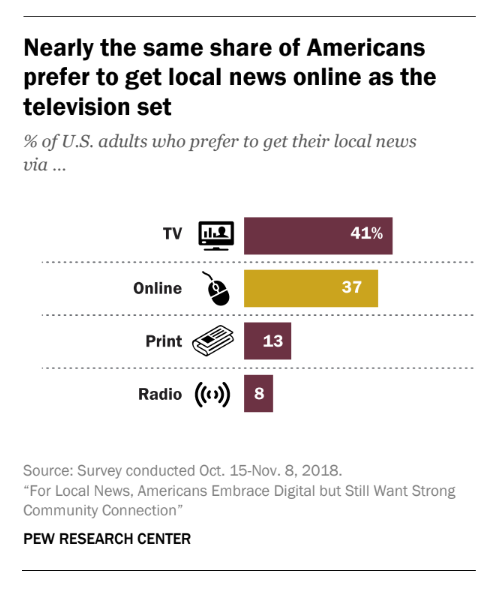Survey: Local TV News Faces Growing Online Preference

The computer is closing in on the TV set as the preferred access device for accessing local news content, news that the majority of respondents still find accurate and credible and transparent, the President's attacks on the press notwithstanding.
That is according to a new Pew Research Center survey of nearly 35,000 U.S. adults.
The survey found that while 41% still pick TV news as their preferred local news outlet, 37% said they would prefer accessing that local news online.

"One overarching takeaway is that even as TV stations continue to have the widest reach when it comes to local news, digital outlets are an important part of the equation," said Pew. "Nearly as many Americans today prefer to get their local news online as from their TV set."
And while online is gaining ground in the preference for where those U.S. adults get their news--or more accurately how they get that news--local TV continues to lead in frequency of use.
The survey found that 38% say they often get news from local TV stations, followed by 20% who identify local radio and 27% who say local daily newspapers. Online-only sources were at 23%, with only a fraction of that saying they often got it there.
The fact that the survey found people going to local TV for local news, but increasingly wanting access online, would appear to signal to local TV stations there could is growth potential in their digital platforms.
The smarter way to stay on top of broadcasting and cable industry. Sign up below
The survey found that currently, the vast majority who get local news from TV stations do so via the TV set (76%), rather than from a station's Web site (13%) or social media account (9%). By contrast, other outlets have a stronger online following, Pew says, pointing to daily newspaper consumers, 43% of which get that news digitally.
While journalists are assailed as fake news from the White House, the survey found that majorities of respondents approved of the job news outlets were doing in "reporting news accurately; providing news that can be used daily; keeping an eye on local political leaders; covering news stories thoroughly; transparency; dealing with all sides fairly; and including people like them in stories."
"Even as the public remains deeply divided in its views of the national news media, the survey finds that most Americans believe their local news outlets are doing a good job in areas such as reporting the news accurately (71% say this), keeping an eye on local political leaders (66%) and dealing fairly with all sides (62%)," Pew concluded.
Certainly local TV is still a moneymaker, but in a response that will likely surprise the many daily newspapers struggling to remake their business models and continue to employ professional journalists in an era of digital transformation, 71% say their local news outlets are doing very well, or at least somewhat well, financially.
The free content model is alive and well. Only 14% of respondents said they had paid for local news in the past year--subscription, donation or membership. The reason: "the widespread availability of free content tops the list at 49%"
Here are some more takeaways that news outlets might want to ponder as they figure out how to grab that growing online-centric audience:
•Across seven core job functions of local news media, the public clearly places top priority on accuracy. Fully 65% name it as the first or second most important function.
• A majority of Americans (61%) say local journalists should not share their views about local issues, while 36% say they should.
• About one-in-five U.S. adults (21%) said it is very important for local journalists to be active on social media sites like Twitter and Facebook, while 40% said it is somewhat important. Roughly four-in-ten (37%) say it is not very or not at all important.
• A large majority of those who get local news online (82%) said an easy-to-use-website is an important feature of an online local news source.
• While somewhat more U.S. adults prefer to get local news through news websites/apps (23%) than through social media (15%), the two have similar overall reach when it comes to local news. Roughly equal portions said they often get local news through news websites/apps (26%) and through social media (25%).
• News alerts are a prominent part of the local news environment. Roughly four-in-ten U.S. adults (42%) get local news alerts on their mobile phone.
Contributing editor John Eggerton has been an editor and/or writer on media regulation, legislation and policy for over four decades, including covering the FCC, FTC, Congress, the major media trade associations, and the federal courts. In addition to Multichannel News and Broadcasting + Cable, his work has appeared in Radio World, TV Technology, TV Fax, This Week in Consumer Electronics, Variety and the Encyclopedia Britannica.

